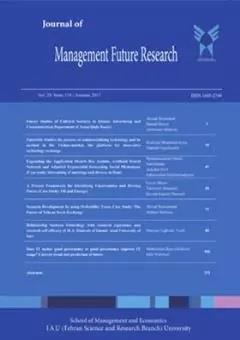Managing ambidexterity innovation in the aviation industry based on open foresight and absorptive capacity
Subject Areas : Futurology
Rasool Rezaei
1
![]() ,
Hessam Zandhessami
2
,
Hessam Zandhessami
2
1 - Department of Industrial Management, Qazvin Branch, Islamic Azad University, Qazvin, Iran
2 - Department of Industrial Management, Science and Research Branch, Islamic Azad University, Tehran, Iran
Keywords: Open Foresight, Potential Absorptive Capacity, Realized Absorptive Capacity, Incremental Innovation, Radical Innovation.,
Abstract :
Background: The innovation ambidexterity refers to the ability to perform two innovative activities at the same time, which is affected by the systematical scanning of business environment and the use of absorptive capacity and extra-organizational knowledge. Objective: The present study seeks to design a structured model for managing ambidexterity innovation in the aviation industry based on open foresight practices and analyzing the role of potential and realized absorptive capacity. Methods: The present study is conducted under a meta-positivist paradigm, and done with a quantitative approach, descriptive-correlational strategy and cross-sectional survey. Data were collected by surveying by 229 managers of R&D departments of aviation industry companies and based on a structured questionnaire with 30 closed questions. CFA technique and LISREL software were used to measure the model validity and hierarchical regression was used to test the relationships between variables. Findings: Open foresight practices have a positive effect on incremental and radical innovation. Realized absorptive capacity strengthens the relationship between open foresight and radical innovation; while this effect is not significant for incremental innovation. Potential absorptive capacity has a positive moderating role in the relationship between open foresight and incremental innovation; while this effect is not significant for radical innovation. Conclusion: Open foresight is a new approach based on the external knowledge absorptive capacity that can improve the performance of incremental and radical innovations, and help companies to shape the future and development of the aviation industry.


